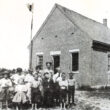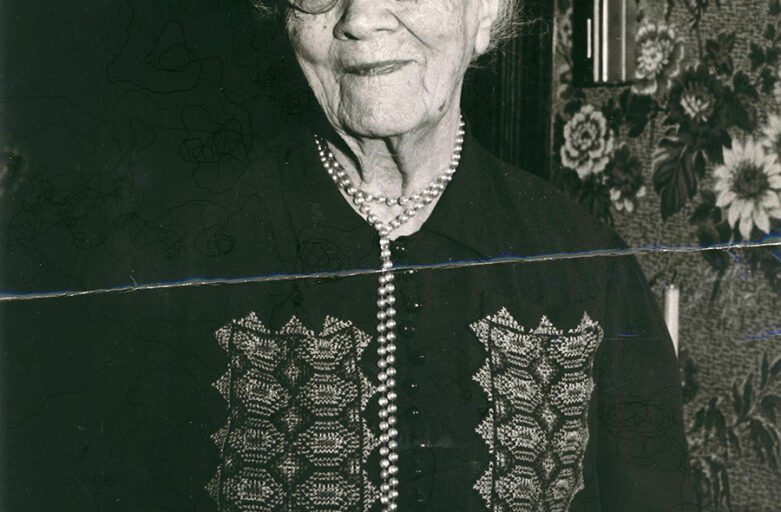In the Bridgton News issue of January 2, 1948, Julia Chadbourne, the 93-year-old correspondent for the News, acknowledges that she is the last Sweden native who personally remembers the Methodist Church at its original location in northeast Sweden. The original church was built by Stephen Sanderson on land adjacent to the homestead of Francis Hamlin (see 1858 map). In 1873, as the center of population of Sweden shifted to the south, the church was relocated to its present location at the Town Center. The church is now known as the Sweden Community Church.
In her article, Mrs. Chadbourne describes the original neighborhood, the move, and the people involved. Her article has been transcribed below.
Julia Chadbourne was born in Sweden in 1854, the daughter of Charles and Eliza Whitehouse. The Whitehouse residence was located on what is now a long-abandoned road in the northeast of Sweden (see map).
Julia Whitehouse was married first to Nelson McIntire (1851-1910) of Fryeburg. After his death, she married Frank Chadbourne (1852-1942) of Bridgton. A graduate of the Gorham Normal School, she taught most of her working life. Her first teaching experience was at the age of 15 when she taught school in Sweden. She went on to teach in Bridgton, Fryeburg, Bolster Mills, and Harrison. She also served for a time as matron of the Lancaster, Massachusetts, Industrial School for Girls.
Mrs. Chadbourne had a long relationship with the Bridgton News where she was a correspondent for North Bridgton beginning in 1912. Her last article for the newspaper was published not too long before her 100th birthday.
Julia Whitehouse McIntire Chadbourne died in 1955 at the age of 100 and is buried in the North Bridgton Cemetery.

 Julia Whitehouse Chadbourne, Age 100[/caption]
Julia Whitehouse Chadbourne, Age 100[/caption]
Transcription of article by Julia Chadbourne
The Bridgton News, January 2, 1948
Some Early History of the Sweden Methodist Church
While attending the Service of Recognition of the Sweden Church into membership of Union Association of Congregational Churches, it occurred to me that I was the only one present who had attended services in the old building which stood in the north part of the town near the old Hamlin house, built in 1813, still standing but long unoccupied.
This part of the town is now called the Brackett Neighborhood. Among my earliest recollections is that of going to church there to hear the new minister, and of saying when asked how I liked the new minister: “I tell you, he’s an awful smart man; you ought to see how he pounded that pulpit.”
I attended the church there until the building was moved to its present location. The reason for the moving was that it would be for the welfare of the church to be nearer the center of population. Towards the North and East, there are many old cellar holes which show where homes once stood, whose owners, as was the custom in those days, were regular attendants at the church.
On the “Goshen Road” leading to North Waterford were several houses, and also on the one leading over “Breakneck Hill” to South Waterford. A schoolhouse stood a little beyond “Chaplin’s Turn.” Some of the pillars of the church still lived in that neighborhood, then called either the Sanderson or the Hamlin Neighborhood. If they were sorry to see the old building torn down they made no sign and there was, to my knowledge, no opposition to the move.
It was a great undertaking for a church of small means, but everyone put shoulder to the wheel, according to ability. A young man happened to be pastor at the time and helped with the courage and enthusiasm of youth. But it was the sacrifice and devotion of some of the members and friends of the church that carried the work through.
Deacon Joseph Perry, who came a babe in this mother’s arms to the place now the summer home of Rev. Pierpoint (sic) Harris and spent the rest of his life there with his wife, a woman of culture and devoted Christian character, and five children, gave all the new lumber needed to build the church to supplement all that was usable from the old building.
A deed of the land on which the church stands was given the church by Benjamin Nevers, one of the Nevers family noted in the early history of the town. He owned a pasture which cornered where the church now stands and from this land was given. I am quite sure also that he gave the land on which the schoolhouse was built. His great grandson and wife, Mr. and Mrs. Charles Bennett, now live in the house at Nevers Corner where he lived.
Deacon Benjamin Holden, who owned the farm where now Camp Tapawingo is located, gave in memory of a deceased daughter, what he called “Martha’s Portion,” which was five hundred dollars in money. Many of the able-bodied men, young and old, gave labor.
The only legacy as far as I know left the Methodist Society there is that of Mrs. Caroline Evans, widow of James Evans. The amount is not known to me.
It was a day of rejoicing when the finished structure was dedicated. The Rev. Frank Strout, a man of some note in the Methodist brotherhood, and an eloquent speaker, preached the sermon, which it was my privilege to hear, and I remember he spoke of the three buildings, located, as may be seen, almost within a stone’s throw of each other, as “The Bulwarks of New England,” –“ the church, the schoolhouse and the townhouse.”
How the venture fared and how the work was carried on may form the subject of another article, if this merits enough interest to warrant it.
JULIA M. CHADBOURNE (The former of Julia M. Whitehouse of Sweden)
- ← James Sands of Maine and The Green(e) Family
- Matters and Things Noticed during a Trip Mountainward →

